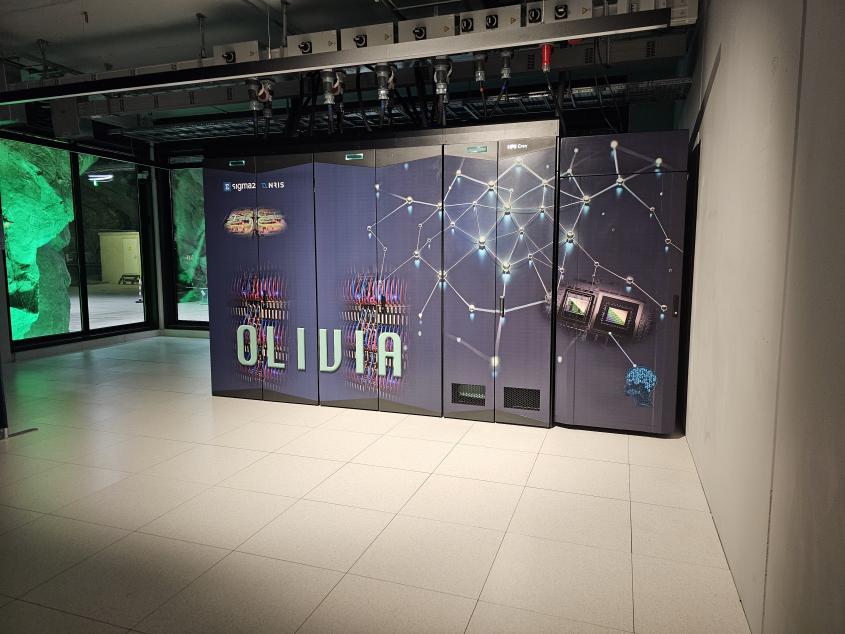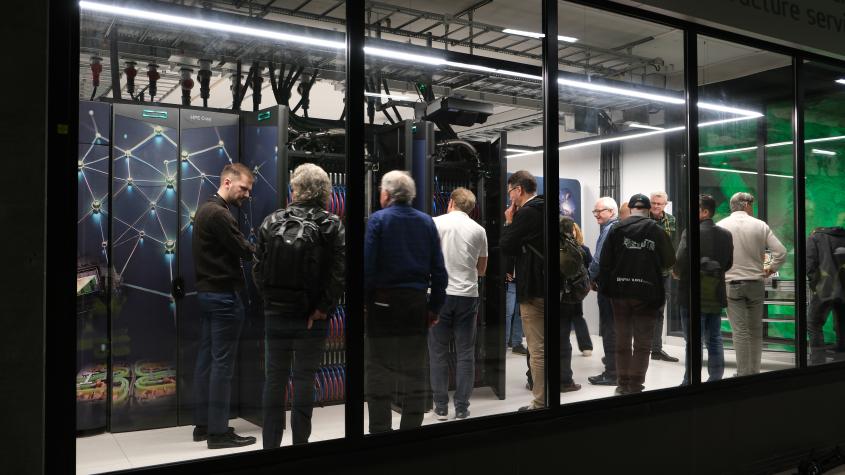Olivia, Norway's most powerful supercomputer, represents a significant advancement in Norwegian research across various fields, including climate, health, oceans, and artificial intelligence (AI).
With its impressive computational power and advanced technology, Olivia offers research environments across the country new opportunities to solve complex scientific challenges.
On Tuesday, 17 June 2025, Sigrun Aasland, Minister of Research and Higher Education (Lab.), officially inaugurated Olivia at the Lefdal Mine Data Centers in Nordfjordeid. The opening ceremony was attended by several prominent guests, including researchers and industry representatives, with Minister Aasland as the guest of honour.
— Today marks the beginning of a new era for research and artificial intelligence in Norway. With Olivia, Norwegian researchers gain the ability to perform calculations that were previously beyond reach in this country. Now, Norway’s research community will have access to the tools they need to keep up with a rapidly advancing field. This is why the Labour Party is committed to strengthening Norway’s position as a leading nation in technology and innovation, said Sigrun Aasland, Minister of Research and Higher Education.
Olivia is equipped with 64,512 CPU cores and 304 of the most advanced GPUs on the market. These GPUs not only offer impressive computational capacity but also support a wide range of software and programming languages critical for data-driven research. This makes them particularly attractive to researchers, especially within AI.

— Olivia is a significant step forward for artificial intelligence in Norway. With this supercomputer, Sigma2 can provide advanced services to researchers nationwide. Olivia will provide a substantial boost to research communities working on complex and socially critical issues, particularly in the field of artificial intelligence, said Gunnar Bøe, CEO of Sigma2.
From Olivine to Algorithms
One of the most exciting applications of Olivia will be the development and training of advanced language models for Norwegian, Sámi, and other European languages. This is crucial to ensure that smaller languages and cultures are not overlooked in the global development of artificial intelligence. Today, the field is dominated by major languages and cultures, as well as a few commercial players in China and the United States.
With Olivia, Norwegian researchers can take a significant step toward developing open, transparent models tailored specifically to Norwegian needs and trained on relevant data.
— Olivia provides us with the computational power we need to develop the next generation of language models for Norwegian. These models can be used for everything from improved language teaching to advanced AI solutions in public administration and the business sector. It is an important investment in both preserving and strengthening the languages of Norway and supporting our unique culture in a digital age, said Svein Arne Brygfjeld, Senior Advisor at the National Library of Norway
Brygfjeld also emphasised the critical importance of providing language researchers with access to powerful resources like Olivia.
—This is yet another milestone for AI research in Norway. Last week, we established six research centres for artificial intelligence, and now they are receiving the infrastructure they need to conduct groundbreaking research. This ensures that the best and most up-to-date knowledge will be available here in Norway, said Sigrun Aasland, Minister of Research and Higher Education (Lab.).
A National Boost for Industry and Public Administration
Olivia is delivered by Hewlett-Packard Norway AS (HPE) and is based on the HPE Cray Supercomputing EX system. The technology allows for future expansion, meaning Olivia can be easily upgraded to meet increasing demand for computational power.
- We are incredibly proud to deliver Olivia to Norway. This project demonstrates how state-of-the-art technology can help solve pressing global challenges and support scientific development in Europe. We look forward to seeing the groundbreaking results Norwegian researchers will achieve with Olivia, said Kristin Ottestad, Sales Director at Hewlett-Packard Norway AS.
Olivia is installed at the Lefdal Mine Data Centers, located 60 meters below ground and 700 meters inside a mountain in a decommissioned olivine mine on Norway’s west coast. This unique facility is powered by renewable energy and features one of Europe’s most sustainable cooling solutions for energy-intensive computing systems. The name Olivia is inspired by the mineral olivine, which was previously mined at the site. The data center also contributes to local employment in the region, showcasing how advanced technology can be combined with sustainability and regional value creation.
- Lefdal Mine Data Centers are specifically designed to handle energy-intensive high-performance computing systems like Olivia. With sustainable operations, high security, and optimal cooling solutions, our data center is perfectly suited for national technology investments in cloud solutions, storage, and high-performance computing, said Jørn Skaane, CEO of Lefdal Mine Data Centers.
Olivia will not only strengthen Norwegian research but also contribute to industrial development and innovation. A portion of its capacity will be available for use outside academia, in industry and public administration, potentially enabling the development of new technologies and solutions to address societal needs across sectors.
Pilot Projects and Future Access
Selected pilot projects are already underway to test Olivia. The supercomputer will open for regular research projects this fall, with a call for access applications to be published soon. Applications will be evaluated based on scientific quality.
Olivia’s Technical Specifications
—We are excited to see Sigma2’s journey of bringing Olivia to life, marking a new chapter in Norway’s supercomputing landscape, said Stephanie Dismore, Senior Vice President, EMEA Regional Sales at AMD. — Olivia’s immense computational power, fuelled by our 5th Gen AMD EPYC processors, will be pivotal in advancing AI, health, marine, and climate research, positioning Norway at the forefront of data-driven innovation. We are proud to be part of this transformative project and look forward to seeing the incredible impact Olivia will have on scientific discovery and technological advancement.
Olivia is a flexible system with the potential for significant expansion, accommodating up to 119,808 CPU cores or 224 additional GPUs, ensuring it can grow with the needs of Norwegian research in the future. The system represents an investment of 225 million NOK.
Olivia is also designed to be one of the most energy-efficient supercomputers in its class. It was recently ranked as the 22nd most energy-efficient supercomputer in the world on the annual Green500 list.
